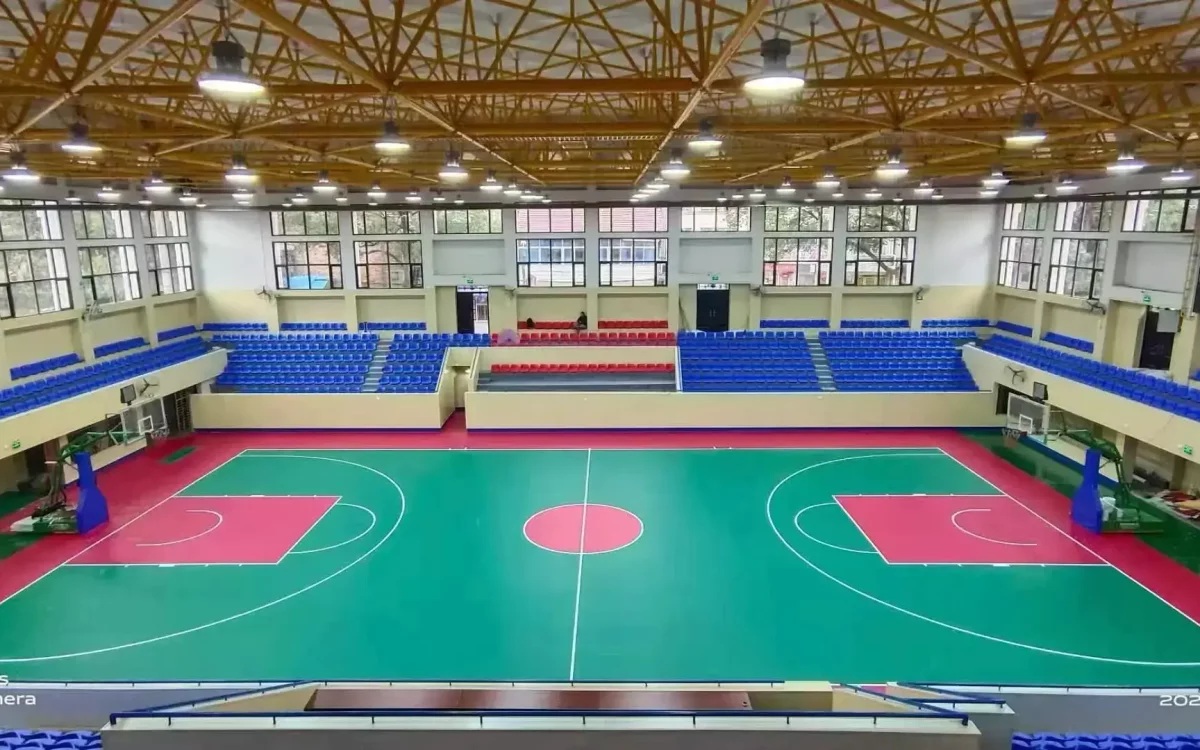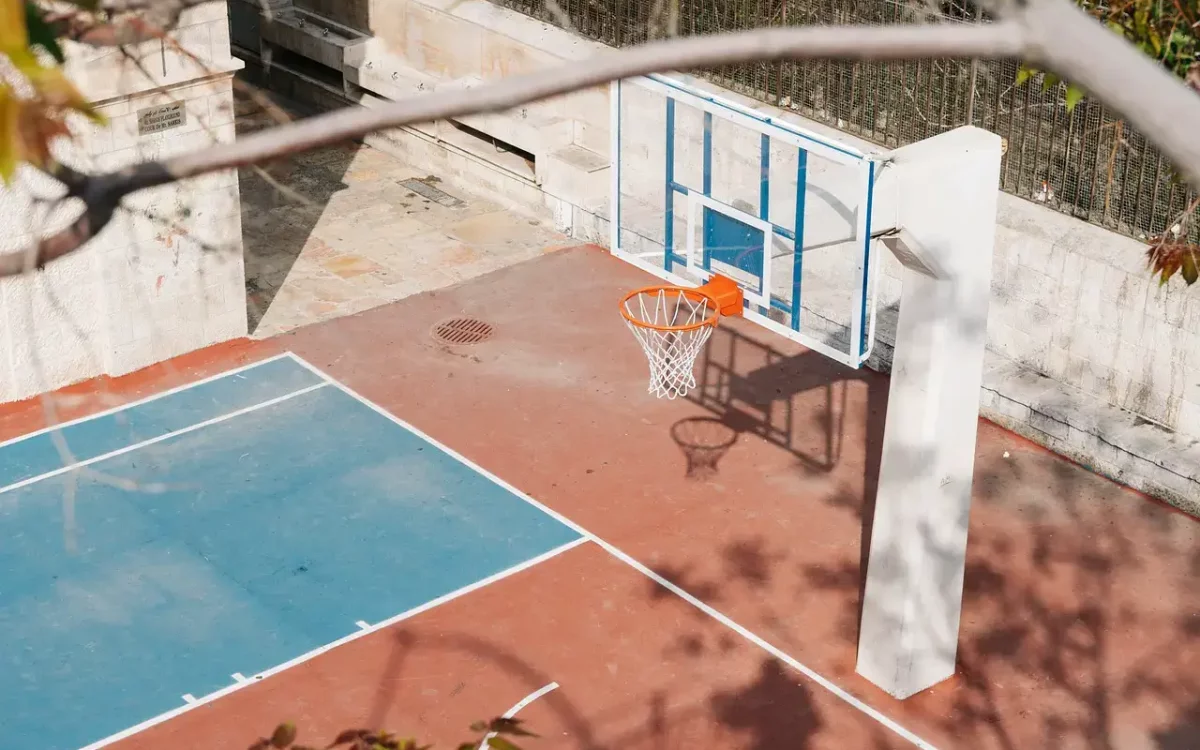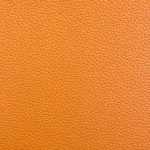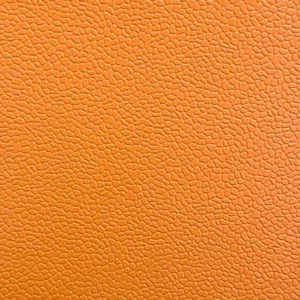When watching basketball, the court surface is the most recognizable element, complete with its standard lines and markings. These basketball court floors appear resilient, robust, and gleaming, maintaining these qualities even during vigorous gameplay. But, what constitutes the optimal flooring type for such courts?
The choice of flooring material holds paramount importance in designing a basketball court. Common options encompass PVC or vinyl, sport tiles, wood flooring, concrete, and asphalt. Notably, vinyl stands out as the favored choice due to its affordability, robust foundation, and appealing aesthetics. Nevertheless, the selection of materials hinges on factors such as court type, intended use, and geographical location.
In today’s market, there is an abundance of flooring options available for basketball courts, making it easy to feel overwhelmed by the choices. This article aims to provide a comprehensive guide to help you navigate through the selection process. We will explore top-notch materials, conduct thorough comparisons, and ensure they meet stringent quality standards.

What Materials are Typically Used for Indoor Basketball Courts?
Since the inception of basketball, indoor courts have predominantly utilized wood as their primary flooring material. Wood flooring stands as the traditional choice for basketball courts, with options ranging from hardwood to hard maple courts. However, an influx of innovative materials is now making its mark in the industry.
Diverse basketball courts feature varying playing surfaces, tailored to specific needs, cost considerations, and intended basketball activities. Among the leading flooring materials in prominence today is vinyl, favored for its quality, cost-effectiveness, and exceptional performance. In the following sections, we will delve into the key factors and advanced attributes of these materials.
Wood Flooring

As mentioned earlier, wood flooring stands out as a premier choice for indoor basketball courts, renowned for its unique structural attributes. The National Basketball Association (NBA) attests to this, as the majority of NBA stadium venues feature this material. The natural hue of wood not only enhances the aesthetics of the basketball court but also optimizes light refraction. Additionally, its lightness provides a distinct contrast, making it easier for players to track the ball’s movement.
Maple stands as the predominant choice for wood flooring, prized for its remarkable resistance to splintering and ideal flexibility that facilitates optimal ball bounce without impeding its speed. This makes it the top pick for both professional and recreational basketball courts. Hard maple flooring takes center stage in the construction of gymnasiums and indoor basketball courts. As previously mentioned, the majority of stadiums and premier NCAA arenas exclusively feature hard maple. The NCAA has even specified the use of 500 northern maple trees to craft these exquisite hardwood courts.
The Maple Flooring Manufacturers Association (MFMA) emphasizes the esteemed reputation of maple as a premier choice for flooring material. This recognition is attributed to its impressive Janka hardness rating, exceptional shock resistance, appealing appearance, and widespread availability. These qualities also contribute to its higher cost compared to alternative options.
Oak materials, specifically white and red oak, stand as formidable counterparts to maple. They boast commendable performance characteristics akin to their maple counterparts. Despite the similarities, many experts and professionals lean towards the utilization of oak materials.

What Type of Wood is Superior for Basketball Court Flooring?
Oak and Maple: Assessing Their Distinct Roles in Basketball Court Flooring
- In terms of appearance, both maple and oak share similarities. Maple boasts a lighter and softer color, in contrast to oak’s brownish and grainy tone.
- While both materials are durable, there are slight differences in their Janka hardness ratings.
- When it comes to pricing, both woods are on the higher end, but costs can vary based on factors like quality, installation, and additional services. Notably, oak tends to be pricier than maple, with prices ranging from $4.99 to $7.49 per square foot. Conversely, maple is priced between $3.74 and $5.00 per square foot.
Given their popularity in professional basketball courts, it’s true that these options can come with a higher price tag. However, if you’re seeking a more budget-friendly alternative for your home court, I have a solution for you.
Beyond wood options, we offer a range of basketball court materials suitable for both indoor and outdoor use, including plastic court flooring. PVC vinyl flooring, a type of plastic flooring, presents an affordable yet high-performing and versatile alternative. Let’s delve into this additional court material.
The distinct patterns found in oak, including wavy figures, stripes, rings, and dots, contribute to its enhanced performance. Additionally, the porous nature of oak significantly influences its material performance. Notably, white oak exhibits superior stability compared to its counterpart, particularly in varying temperature and humidity conditions. However, for those seeking a budget-friendly alternative, oak may not be the optimal choice. It tends to come at a higher price point compared to maple and other wood options.
Several basketball courts opt for more budget-friendly alternatives like hardwood flooring. However, it’s important to note that while these options are cost-effective, they may not offer the same level of performance and safety as maple and oak.
Vinyl Sport Flooring

Manufacturers have made significant strides in creating synthetic plastic materials that offer robust strength, ideal for basketball court surfaces. These materials not only mimic the aesthetic of wood but also replicate its performance characteristics. This includes outstanding durability, enhancing safety for players. Additionally, they boast excellent traction, superior shock absorption, and improved bounce.
Versatile in application, vinyl, a type of plastic, finds extensive use in various spaces such as conventions, parties, and sports events like basketball. It stands out as a prominent choice for both indoor and outdoor basketball courts. When compared to alternative materials, vinyl offers a wide array of color options and can rival the performance of wood. In fact, most vinyl surfaces provide a higher bounce during dribbling compared to hardwood. Additionally, it excels in safety, offering increased impact resistance and enhanced shock absorption, minimizing the risk of injuries from falls.
Look no further than our premium vinyl basketball flooring – it’s the pinnacle of materials available in the market. You’ll experience seamless practice sessions, whether you’re honing your dribbling, running, executing turns, or perfecting your free throws, thanks to its highly wear-resistant surface. Additionally, our vinyl flooring boasts remarkable impact resistance, superior shock absorption, and exceptional elasticity. Its high friction properties ensure athletes can move freely, pivot in place, and rotate without constraints. What’s more, it’s eco-friendly, and its hassle-free installation process adds to its appeal.
At LAIKEMAN, we prioritize the production of top-tier vinyl flooring, ensuring it meets the highest standards of quality. We understand that the quality of the surface directly impacts the health, comfort, safety, and performance of basketball players. With this in mind, we provide an unwavering guarantee that you will receive the finest surface material for your indoor basketball court.
We offer a diverse selection of vinyl patterns, including:
- Maple Wood Series
- Oak Wood Series
- Big Stone Series
- Gem Series
- Coral Sand Series
- Diamond Series
- Grid Series
- Pomegranate Series
- Olivine Series
- Crystal Sand Series
Depending on your specific application, you have the flexibility to choose from various patterns. For basketball courts, the standard and widely favored pattern is the classic wood design.
In addition, we offer a range of thickness options, starting from 4.5 mm and going up to 8.0 mm. The choice of thickness will be contingent on the specific basketball court you are establishing. Regardless of the selected thickness, you can be assured of a robust and long-lasting layer that can endure the demands of any basketball activity.

What Types of Materials Are Typically Used for Outdoor Basketball Courts?
The process of waterproofing, while essential for preserving wood floorings like maple and hardwood, can diminish many of their inherent benefits. This is a key reason why they are not considered ideal choices for outdoor basketball courts.
Hence, a number of readily available water-resistant materials have become popular choices. Concrete, asphalt, and plastic are commonly used in the construction of outdoor basketball courts. Considerations such as reduced risk of skin abrasions and low maintenance requirements add to their appeal. Additionally, their ability to withstand harsh weather conditions is a crucial factor. However, determining the optimal materials will ultimately hinge on budget constraints, location, and the intended users of the court.
Concrete

A robust option, such as concrete, proves to be an exceptional choice for outdoor basketball courts. Not only is it cost-effective, but its smooth surface significantly enhances basketball performance. Constructing a concrete foundation is also a straightforward process, requiring only basic equipment and labor for the mixture to be poured and set.
By applying a sealer and vapor barrier, the longevity of the concrete surface can be further extended. This treatment equips it to endure both scorching heat and freezing temperatures. Additionally, the option to incorporate acrylic re-surfacing paint for court markings adds another layer of customization and durability.
Asphalt

Asphalt provides a sturdy surface with a range of options from smooth to slightly textured. Its slight softness ensures comfortable dribbling, but caution is advised to prevent scrapes or falls. Fortunately, asphalt demands minimal maintenance and its dark hue effectively conceals dirt, offering both durability and aesthetic benefits.
While asphalt proves resilient against inclement weather, it may not provide a long-term solution. Over time, the surface tends to develop cracks and other issues, ultimately leading to a shorter lifespan and potential structural deterioration.
PP Interlock Tiles

Have you ever attended an amateur outdoor basketball competition? If so, you might be acquainted with basketball court tiles.
Basketball court tiles offer exceptional shock absorption, making them ideal for recreational use. Their flexibility allows for customization to cater to the specific needs of players.
Opting for tiles can be an excellent choice if you’re looking to construct a flexible and easily replaceable outdoor basketball court. However, it’s important to note that if you choose pp interlock tiles, their lifespan is relatively shorter. Typically, you can expect them to last for another 10 to 15 years at most.
What Factors Should You Consider When Selecting a Basketball Court?
Is it accurate to assume that all basketball courts are created equal? Are their flooring materials, quality, and thickness consistent across the board? The reality is quite the opposite.
The International Basketball Federation (FIBA) has established a comprehensive set of rules and regulations governing the specifications of basketball courts. These guidelines take into account technical, financial, and sporting considerations. Whether you’re constructing a court for outdoor or indoor play, be it for professional or recreational use, it is imperative to adhere to these regulations, regardless of the cost of materials.
- Due to their flexibility, the flooring must effectively absorb both players’ movements and the ball’s impacts.
- The entire surface area should be uniformly flat and level.
- The chosen flooring material must exhibit consistent point elasticity across all surface areas.
- It is recommended that the floor’s color be subdued, with a reflected light factor ranging from approximately 0.25 to 0.50.
- The floor surface should be uniformly smooth and capable of absorbing bounce.
- Players should experience ease of movement across the floor’s surface.
- Incorporating sound absorption measures is crucial to minimize excessive vibration and noise.
- Ensuring adequate shock absorption capabilities in the chosen flooring materials is essential.
PVC Vinyl Flooring

As previously noted, plastic proves to be a versatile choice for both indoor and outdoor basketball courts, excelling in both performance and structural integrity. Its UV resistance provides essential protection against harmful ultraviolet rays, ensuring a safer playing environment. This feature not only reduces strain on your knees but also minimizes the risk of severe falls.
Upon installation, you’ll be greeted with a picturesque outdoor basketball court, creating a visually appealing and inviting space for play.
Moreover, plastic materials can be installed independently or layered on top of concrete, a method known as the ‘Multi-Purpose’ approach. This integration enhances player safety by offering superior traction. Additionally, the risk of abrasion is minimized, and the ball experiences a consistent bounce.
Vinyl basketball court flooring proves to be a versatile choice suitable for both indoor and outdoor settings, offering a host of benefits and high performance. In the following sections, we will delve into the numerous advantages that make vinyl material the optimal choice.

Resilient and exceptional durability
Among the materials listed, vinyl emerges as the standout choice for outdoor basketball courts. Its robust composition ensures longevity over the years. The flexibility and elasticity of the vinyl surface contribute to its sustained performance and durability. Whether you’re constructing a professional-grade basketball court or a backyard play area, investing in vinyl proves to be a wise choice.
Little Maintenance
The majority of vinyl floors feature a non-linear texture, providing exceptional traction for players. This texture proves highly practical as it prevents dirt and debris from adhering to the surface, making it easy to clean with a simple sweep. Additionally, using a damp mop with detergent and soap can help maintain its pristine condition. With regular upkeep, your basketball court will retain a fresh and vibrant appearance.
Bouncing and Stability
Vinyl is highly resilient to temperature variations, pressure, and humidity levels. While some lower-quality vinyl may experience minor surface changes over time, this largely depends on the specific brand and grade. This is where TeeLand Vinyl Sports Flooring and PVC vinyl truly shine, offering a premium product known for its exceptional durability and high-quality standards.
Multi-purpose plastic flooring
Vinyl stands out as one of the most versatile flooring options for sports and commercial applications. This material offers a range of functional advantages. Notably, it closely resembles traditional hardwood court flooring while being cost-effective, of high quality, and equipped with advanced features. Its adaptability extends to various sports including street hockey, volleyball, and basketball.
Cost-Effective
When considering flooring options for a basketball court, vinyl proves to be a more budget-friendly choice compared to other alternatives. TeeLand’s vinyl sports floor is particularly notable for its easy installation on various surface areas. The materials we utilize offer stability, comfort, and impressive durability. Furthermore, the long-term cost of maintenance and cleaning is significantly lower, making it a cost-effective investment.
Conclusion
To dispel a common misconception: while wood is the most favored material for basketball courts, it is by no means the exclusive choice. There exists a diverse range of materials utilized in basketball court construction. If you have a keen interest in basketball or have been in a basketball-centric environment, you may already be familiar with some of these options.
Vinyl sports flooring, wood, and concrete stand as the customary choices for basketball courts, whether in professional arenas or recreational settings. The selection of the most suitable flooring material hinges on various factors including specific requirements, budget considerations, design preferences, and performance expectations. It’s worth noting that all the materials listed here are viable options, offering excellent solutions for both indoor and outdoor basketball flooring needs, with vinyl particularly standing out.










